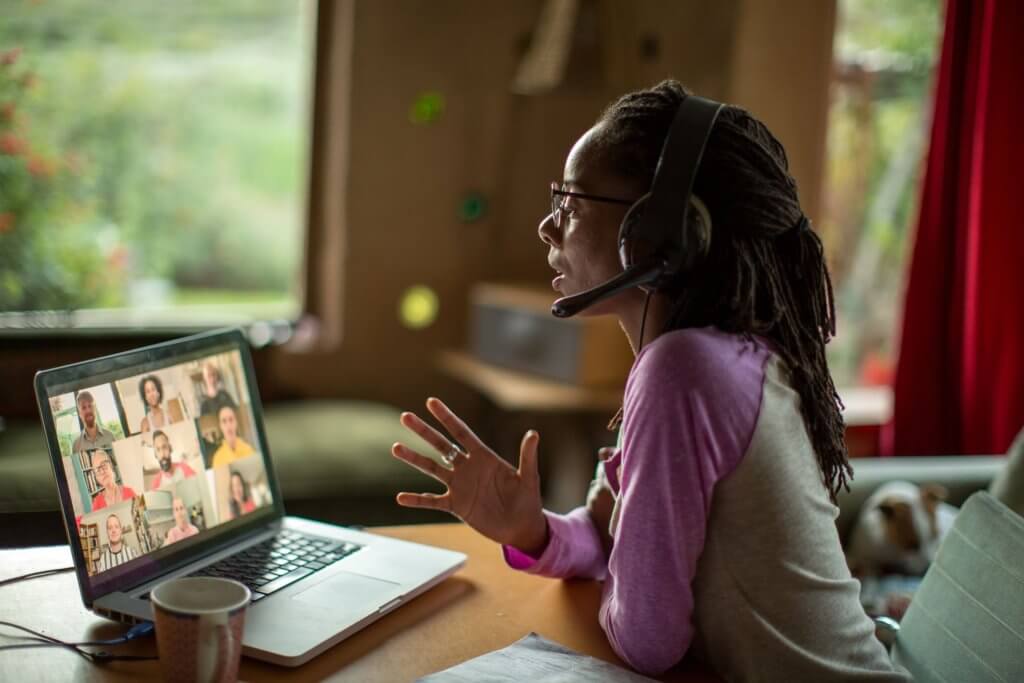04.08.2021 by Infogram
Student engagement has always been a focus for educators. How can you hold the attention of your class when their ability to focus is waning? And more importantly, what student engagement strategies foster a greater desire to learn?
With remote learning, the discussion of online student engagement has risen dramatically. Many teachers are wondering how they can bring a spark to a student’s eyes when they’re teaching remotely.
Read on to learn how to tackle student engagement online, and get the answers to common questions, like:
- What is student engagement?
- What are the different types of student engagement?
- Why is online student engagement important?
- And discover 12 proven activities to increase student engagement during online learning.
What is student engagement?

Student engagement is “the degree of attention, curiosity, interest, optimism, and passion” students express during the class. In other words, it’s their will and ability to get involved in the learning process.
With online student engagement comes additional concerns.
- Will they turn on the camera during the lecture? If not, are they present?
- Are they watching the presentation or scrolling their social media feeds?
- Do they ask questions and get involved in discussions?
- Do they get their homework done by themselves and in time?
- How to develop networking and communication skills for children in the digital era?
Types of student engagement
There are two forms of student engagement: Ongoing engagement and reaction to challenge.
Ongoing engagement refers to student behavior, emotions, and thought processes during learning. Think about it in three parts:
- Behavioral engagement is about the effort and time students spend learning and focusing, the ability to stay on task, and how they show initiative when given the opportunity.
- Emotional components refer to positive attitudes that students exhibit during learning activities, such as enthusiasm, curiosity, and interest.
- Cognitive engagement is about students’ understanding of why they are doing what they’re doing and why it’s essential.
Reaction to challenge refers to students’ coping strategies for dealing with challenges in school like failures, bad grades, and withdrawals. They tend to use effort, strategic thinking, problem-solving, and experiments to deal with those challenges.
But why is online student engagement important?

When students are engaged, their academic performance improves. It results in higher grades and greater motivation to learn new things, develop skills, and deal with challenges.
Face-to-face learning is effective in bringing in positive behavioral changes along with improvement in students’ academic achievements. In contrast, online education gives greater autonomy to students.
They can study at their own pace, or use the abundance of multimedia and on-demand content to study faster than they would in a traditional setup.
12 online student engagement activities
Use the following ideas in your online classes to boost student engagement.
1. Use stories in the online learning process

Storytelling is one of the most powerful tools to convey an important message to another person. It provides deeper meaning, and context, and brings knowledge and truth to life.
Students remember stories much longer than statistics or facts. I still remember learning about the story of the Trojan Horse in my world history class. Would I remember anything if my teacher had just talked about the time of the Trojan War? I don’t think so.
You can literally tell anything like a story, not just historical events or biography.
Combining storytelling and data visualization can make a difference by triggering your students’ visual perception. Empower your students with visual learning by using creative infographics, charts, presentations, and other data visualization formats. That can add massive value to every story you tell, as 65% of all of us are visual learners.
2. Go beyond traditional online lessons with Prezi Video
Instead of sharing your screen, use Prezi Video to connect to any video conferencing platform and show your content right alongside you as you present.
Why should you try it?
- Prezi Video will surprise your classroom and keep them focused.
- You will no longer be a small rectangle in the corner of students’ Zoom, Google Meet, Microsoft Teams, or any other video meeting. With your slides appearing next to you on screen, you can grab students’ attention and boost online student engagement.
- Prezi will inspire you to try new formats in storytelling, presenting, and creating assignments. Also, students will develop their creative and presentation skills with every homework assignment.
- You can use Prezi Video to present in online lessons (regardless of the video conferencing app you’re using), and easily record videos for students to watch and rewatch anytime.
- Students love Prezi. See what educators say about their experience with Prezi Video.
3. Encourage accountability in the classroom
A culture of accountability plays a vital role in society. In the classroom, it means that every student knows their role and accepts responsibility for fulfilling it, whether it’s a group project or individual work.
Engage your students in group projects to teach them all the necessary skills of teamwork, such as dealing with responsibilities, showing initiative, staying accountable for assigned tasks, learning time and quality management, communicating with different people, and so on.
Not everyone feels comfortable when working in groups, but it’s crucial to practice accountability now in order to be a better team member later in life.
4. Update and improve online lessons
While the facts and history may not have changed, the approach on how to express them has. There’s nothing unusual about sharing the same .pdf files or presentations with students year after year, but a little format experimentation never hurt anybody.
Here are some ideas:
- Record a video to explain complex ideas like math formulas or Newton’s laws. By that, you will help students understand the material thoroughly and have a video they can rewatch whenever they forget something.
- Create an infographic to tell a story in an engaging and easy-to-understand format about a specific event, person, or process. You can include texts, charts, timelines, maps, images, videos, and even GIFs and stickers to catch students’ attention.
- Express geographic information with customized maps. Students will learn the geography of countries and cities and understand the data better because they can visualize it.
- Build zooming and engaging presentations that emphasize the story in-depth, not just move from one slide to another.
- Use dashboards and reports to build comprehensive material with plenty of data, numbers, and charts, like regional financial development reports or election results.
- Create posters to draw attention to important messages like equality in society, cybersecurity, or fun events.
Take a look at this in-depth, interactive solar system infographic made with Infogram.
Pretty cool, huh? If you’d like to view it in more detail, open this link and click the button in the top right corner to view it on full screen.
5. Try different feedback methods to engage students
Feedback is something that tends to be underrated among students. Giving and receiving constructive feedback is actually a kind of “art for better social living,” so it’s a great idea to include it into your online lessons.
You can emphasize the importance of feedback in three ways:
- Ask students to evaluate your work. Let them rate the lesson material and their feelings during the lesson. Their answers will help you improve the material or your approach, and bring new ideas to your online classes.
- Ask students to give feedback to each other using the traffic light approach or any other feedback method. They can highlight good things about classmates, areas of improvement, and learn to express criticism in a way that doesn’t hurt anyone.
- Give feedback to your students. This one is critical – an individual approach will engage students and make them feel important and appreciated. Feedback will build trust between you and students and motivate them to work on their weaknesses.
Collect quantitative feedback and create a dashboard with results at the end of the semester. You’ll see what’s changed and how you’ve developed.
The sooner students start to develop the skill of giving feedback, the easier it will be to become team leads, communicate with others, express their opinions, and deal with criticism.
6. Engage students during online lessons with live reactions
Interactivity can be a headache for every virtual presenter. Many video platforms allow you to add reactions during a virtual call like applause or a thumbs up or down, but that’s just the tip of the iceberg.
Take student engagement to the next level, allowing them to instantly show a picture, video, GIF reaction, or sticker right next to their face with Prezi Video.
Here’s an idea: Ask students to share a GIF expressing how they feel when the lecture starts. That’s a great way to break the ice, lift the level of energy, and choose an approach based on how they feel today.
7. Mood boards for online student engagement

A mood board is a well-known type of collage with text, images, objects, and compositions. It is often used in interior design, event planning, and fashion to visualize a particular style or concept.
It’s also a fun idea to use in education. When you make mood boards, periodically ask your students to visualize what they’ve learned, what emotions they experienced, or whatever is on their minds right now.
How? Encourage students to sign up in visualization tool like Infogram and create a mood board with images, icons, fun GIFs, videos, and text. In this way, they can express themselves in endless ways, showing their creativity, wit, and knowledge, and you’ll have valuable feedback about your work.
8. Mini TED talk contest

Presenting is a set of skills, ranging from time management and information analysis to visual content creation and public speaking. Everyone should begin to develop presentation skills during their school time.
Inspire your students by offering a collection of the most remarkable TED talks about topics they might find interesting, such as science, nature, relationships, technology, and design. Let them see what a great TED talk looks like, discuss the components of a successful presentation, and encourage them to create one by themselves.
Make a list of topics (plus a free choice), set the deadline and speech requirements, and give them tools to create an outstanding virtual presentation like Infogram’s slide templates or Prezi’s student software.
And what’s most important – make the day of virtual presentations a celebration! Presenting in front of an audience is not easy. It’s a huge step your students will make towards their growth. Celebrate these wins together!
9. Debate: The highest level of student engagement

Organizing debate virtually could be a challenging task, but it’s totally worth it. Debate stimulates student engagement, critical thinking, and helps develop speaking skills.
Create small groups of 4-5 people, assign debate topics, and raffle a position for each group. To provide insight into the case, you can create a comparison infographic with some ideas, resources, or data.
Every debate comes together with a gamification and competition element that urges students to learn the topic, stick together, prepare bold arguments, make a great speech, and win. Enjoy the battle!
10. Flipped classroom for deeper discussions
In the flipped classroom model, traditional ideas about classroom activities and homework are reversed. Students interact with the lesson materials individually at home as text, pre-recorded video, or data visualization projects. Online classroom time is reserved for discussions and interactive projects.
The goal of a flipped classroom is to make a virtual class an active learning environment. Students are able to learn at their own pace, and the educator has more time for one-on-one time with each student.
11. Student collaboration for increased engagement
Encourage students to collaborate and work together with each other. It’s especially crucial in online learning.
Offer a wide range of group activities: Fun sessions to get to know each other, breakout rooms for discussions, group projects, “study buddy” programs, and more.
All these group activities provide students the socializing experiences they miss out on because of remote learning and give them the chance to improve communication and problem-solving skills and learn from each other.

12. Assign interactive homework
Homework is an integral part of the learning process. Do students like it? Not always. But there are ways to offer practical projects that can engage students. Here are some examples:
- Encourage students to create a synopsis about the topic in any form they like. For example, comprehensive infographics, blog posts, animated or recorded video, presentation, web page, essays.
- Assign group projects that encourage students to express their creativity to its fullest and acknowledge when they make extra effort. If it’s a research project about cultural diversity, inspire them to wear suitable clothes and makeup, try out an accent, learn some rituals. Help their creativity thrive!
- Involve social media by letting them discover and explain how the TikTok algorithm, Twitter hashtags, or Instagram feeds actually work. Social media is where most students spend their time every day, so you can use their natural interests for educational benefit.
- Develop students’ ability to analyze information, find the central message, and create dashboards, charts, and reports even without design skills.
- Use different education tools for digital engagement and deeper learning like Brilliant and ixl.
- Prepare for class before the class. Bring the knowledge to students before the online course starts with pre-class quizzes to evaluate their knowledge, add gaming elements, and create a hook for further learning.
- Make students’ concerns and questions part of your lecture plan. Create a form where they describe a situation that you’ll later solve during the class, for example, some confusion about personal finance or pet care.
So, what’s next?
Online learning is here to stay – and you’re doing great!
Reading this article means that you’re ready to work on your teaching techniques and improve online student engagement.
You’re not alone. We at Infogram offer a wide range of templates designed to help educators and students create data visualization projects quickly and effortlessly.
Get data visualization tips every week:
New features, special offers, and exciting news about the world of data visualization.